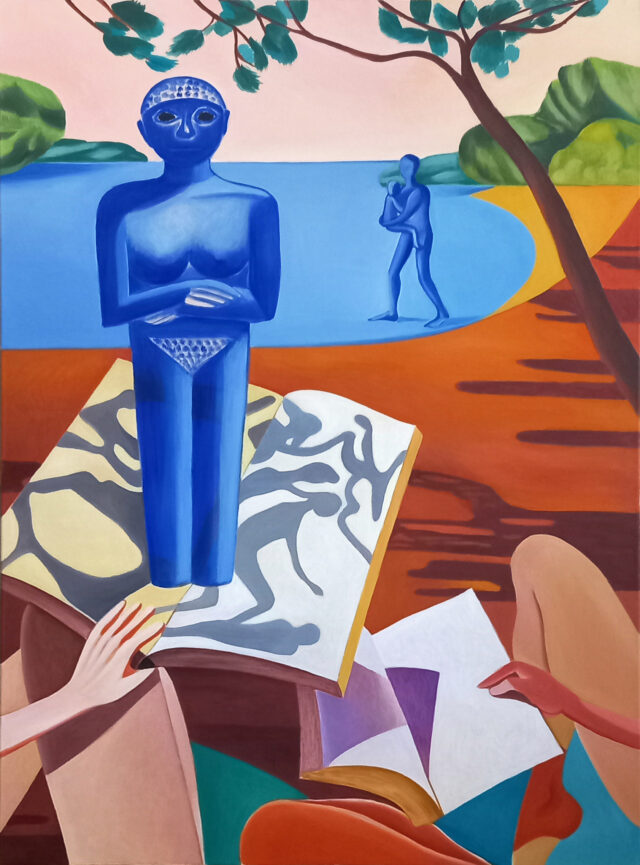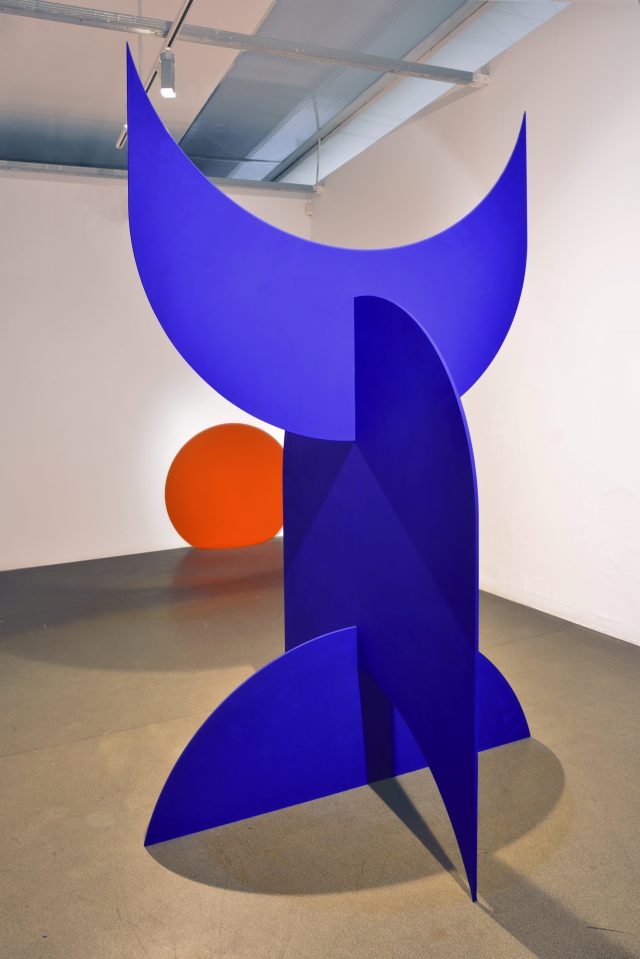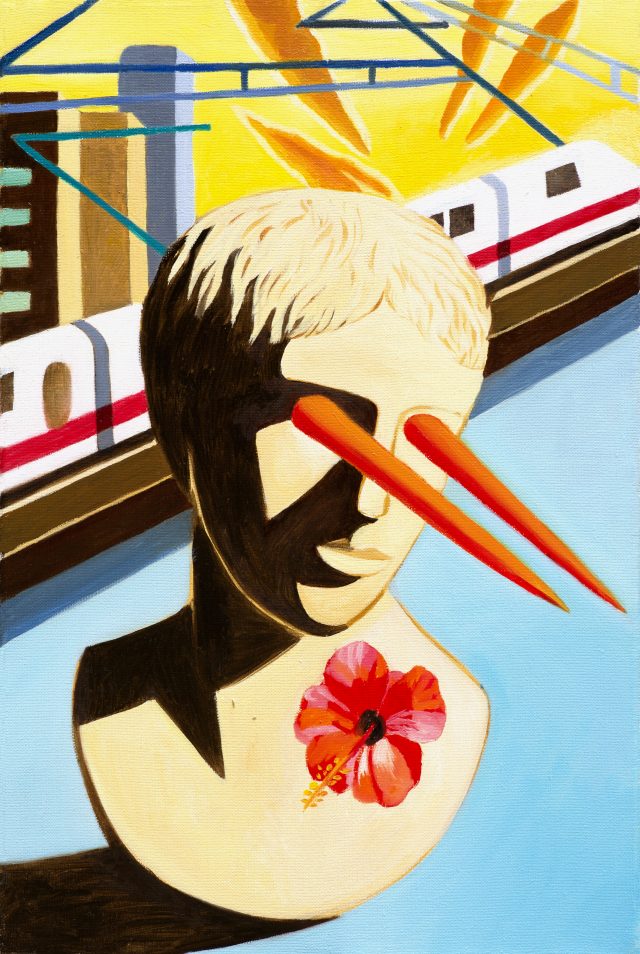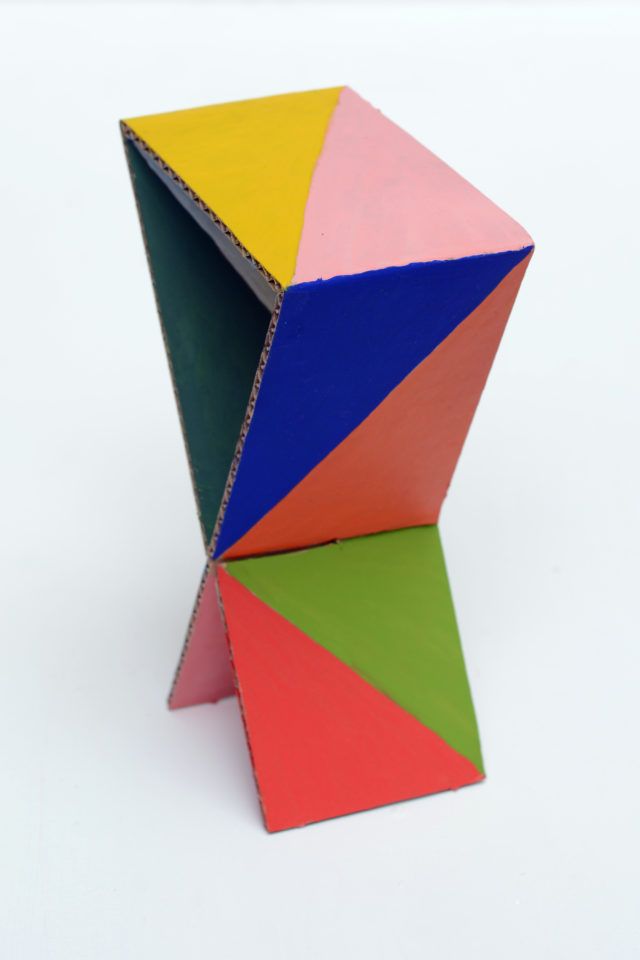Abstraction
For the last few years, Kinga Nowak has been involved with the modernist tradition, and abstraction has entirely dominated her work. The artist vivifies the geometric version of non-representational art, but no sign of detached numeral canons, the rigour of calculated proportions, or merciless precision of composition is to be found here. Creating paintings, objects, larger spatial arrangement or – recently – fabrics, the artist evokes the robust and energetic spirit of geometry. She draws inspiration not only from the interwar period, but also from later waves of interest in abstract art. But it is the early employment of this kind of artistic language that remains the main reference point for her work.
Her pieces are infused with a warm and “humane” atmosphere. This makes the reference to the early avant-garde even more evident. In the early twentieth century there were no advanced technological means to aid the process of creation, and the effects of industrial production were replicated by hand. For instance, Henryk Berlewi’s Mechanofaktury were lithographic prints. The simple material basis was consistent with the idea of the human scale of artworks. Very often this scale is decreased a few degrees below the ‘natural’ size of things in relation to humans. In this way, works, sculptures, objects could be used as models – and that was frequently the case. This is true for small-format sculptures by Katarzyna Kobro or Henryk Stażewski’s reliefs. At any rate, the way of manufacturing objects radically affected the shape of modern art: millions of identical items turned out in years to come led to dehumanisation of art. Kinga Nowak has no doubt learned her lesson in minimalism which, as a late American echo of constructivism, entirely deleted the human perspective from works of art. The artist, however, has decided that the reverse direction would be better to pursue her objectives: she keeps human beings in mind – those that will view her works and be among them. She chooses the scale properly, allowing for various viewpoints and perspectives that change as the viewer moves.
Constructivism arose in Russia from where it radiated towards the West; under the influence of the latter Central and Eastern Europe developed local variations of geometrical abstraction. Each variation comprises a similar set of concepts, stretched between the poles of anarchistic utopia and mystic spirituality. In Poland, the movement inspired Władysław Strzemiński’s Theory of Vision, which scrutinised the act of looking at material, physical, and bodily levels. Kinga Nowak’s works owe a lot to avant-garde investigations of visual perception, and visual memory finds a powerful expression in her paintings and other pieces. Seeing is a phenomenon treasured by the artist, but it also defies all avant-garde’s attempts at categorising it scientifically. Much more, her postmodern work reveals the artist’s admiration for optical games, and its chief aim is to provide visual impressions. Vivid, uncompromising colours create a glow and divert attention away from the work’s structure. The body has disappeared, what remains are afterimages – to remain by the reference to Strzemiński, this time in the later period of his artistic career.
When discussing the drawing of inspiration from the avant-garde achievement, one faces the problem of replication. An exact repetition of historical poetics would never produce moving and living modern works of art. The language of contemporary works has not, after all, sprung from the ideological ferment around Mondrian or Rodchenko. Kinga Nowak appropriates elements of that language, rather than copying them. She rejects the political aspect, the plan to build a newer and better world. And there is not a single resident of this world in her work standing compliantly side by side with other new people. Admittedly, we are currently at cultural and historical crossroads, a time somewhat like the days that saw the birth of the avant-garde a century ago. Just like then, we are witnessing disintegration of forms belonging to the old order, and there is no way of knowing what is going to supersede them. However, no revolution is raging right now, the world is not recovering from another great war. Today, we take mass production, only emerging back then, and the social changes it brought about for granted. And yet, art has become a faint shadow of what it was one hundred years ago. Digital technologies of image creation and multiplication have sucked art dry of its life force. And images have flooded the world causing people to cease to attach any significance to them.
Kinga Nowak’s pieces constitute a response to this state of affairs. By painting pictures the artist tries to find her own way through the excess of visuality. She turns to private, individual encounters with art with their little pleasures, deciphering past codes, and reusing old artistic languages. Her works are unpretentiously elegant and slightly nonchalant. They promise sublimity, but what they give is delight. However, staying within the framework of the language of art without venturing into, for instance, the social sphere, Nowak’s works are inevitably confronted by the question of ‘formalism’, highly unpopular in Poland.
The problem came up in the days of the Polish People’s Republic, when artists were upbraided by communist comrades for falling under the influence of “rotten imperialism”, symbolised by formalism. The low opinion is reinforced nowadays by the art market which promotes formalism as a kind of art secure for buyers as it is not ideological; for this reason it is also encouraged at art schools. It can be considered empty and cynical, but it can as well stand for the need to return to art as a repository of values. Whatever the reason, we have been observing a deluge of ‘formalist’ styles and poetics reappearing in recent years in Poland. Surrealism has been dusted off and enjoyed, abstraction came back in a variety of forms.
Curtains
The content of an artwork is becoming unreliable. It is being replaced by marketing, PR, or advertising slogans, as well as any other kind of slogans generated by sophisticated techniques of steering society. Is the meaning of art recoverable at all? It is not to be looked after in easily manipulated ideologies, but on the surface of things, in what is aesthetic. Some guidelines can be found in the writings of post-Marxist philosopher Jacques Rancière, quite popular nowadays, but also in the very different views of art historian Wiesław Juszczak. An analysis of Mrs Dalloway by Virginia Woolf, the great masterpiece of modernist literature, carried out by the latter, may prove useful while interpreting Kinga Nowak’s work. It is after all not formalism that characterises her pieces the most, but the reference to modernism in its prime.
It is already in Mrs Dalloway, published in 1925, that we can see the process of the draining away of sense. This is why the book is regarded as a harbinger of the end of “the age of the novel” and the dawning of a new era still here, permeated by visibility (to the disadvantage of words). It is thus situated at the border between modernism and what was beginning to oust it, termed postmodernism by some. The book, most intricately structured, disregards the rules of the genre, and yet it remains a novel. The narration loops, pays no heed to probability or cause-and-effect relationships, while minor elements become more prominent than major ones. One of the motifs in the book is a curtain with birds of paradise. Mentioned only casually here and there, it occupies an important place on a deeper level. Apparently meaningless, the yellow chintz curtains blown out by the evening air. Without giving it a thought, one of the guests attending the party given by Clarissa Dalloway pulls them aside. At that moment, the hostess sees reality complete at last, with all its discrete elements falling into place. Mrs Dalloway finally finds peace, the party is a success. The movement of the curtains makes the chaotic element of the real life freeze into a crystal work.
The curtains may indicate what is visible and what we experience on a daily basis. They may draw our attention to what is hidden behind them. The pattern on the chintz is that of “birds of Paradise.” Birds evoke in us similar associations. The decoration painted or printed on fabric (beautiful birds, soaring through the air, messengers from Paradise) conceals something, while at once suggesting it, pointing at it. The motif on the curtain takes us to the threshold of a deeper, hidden order which can only be sensed or perceived by impulse, via an incident that is seemingly inconsequential.
Kinga Nowak’s abstract works – paintings or spatial objects, large or small – strike the viewer with their intensity. The intensity of presence and colours. I will only add that three-dimensional objects seem to be a continuation of what has been designed in painting. In a way, the latter seems to provide colourful models to be assembled or, anyway, visions of constructing or organising space based on geometric solids. Although Kinga Nowak’s works do not serve any useful function, they do not create the impression that they are nothing but an empty ornament or packaging. Their surface is saturated with colours. Sometimes the background comes through, usually some easily available material such as, for instance, corrugated fibreboard. These simple and pure pieces expose a striking contrast between mundane materiality and their intense existence. The artist has managed to capture the visual impression and to change its ‘state of matter’. A transformation has occurred – something transitory has metamorphosed into a preserved moment, a frozen stream of memory. Elements of chaotic life have been united to form one crystal clear composition.
Also rooted in painting, the large-format fabric is a curtain with no additional comments or explanation. It looks like the surface of a picture suspended from the ceiling. Just like other works by the artist, it forces the viewer to move. Here – to walk to the left (there is a hidden passage between the folds). The fabric falsely promises that you can enter the painting or have a look at what is behind it. Larger objects from the category of ‘post-painting sculpture’ act in a similar way. They encourage the viewer to circle around them, to step inside them, to change perspectives. As I have mentioned before, they always relate to the external human point of view and to the bodies of people attending the exhibition, viewing the works.
In art, the objective is form, wrote Juszczak in his analysis of Mrs Dalloway. The materiality of the work is to be flouted in the pursual of form because it is not a component of particular pieces, but a constant unity, regardless of the shape a work takes. It can be found in an ideal world somewhere and is consistent with the Neo-Platonist tradition. Juszczak points out that between the ‘formal’ layer and the ‘sensual’ (or visual, material) layer there is a gap for which he uses the term “ontological void.” What we can sense in the work “leads us to a «threshold» the crossing of which cannot be verbalised.” This very “threshold” can be sensed in Kinga Nowak’s abstract works. It is the limit transitory impressions cross to freeze into a picture.
In her work, the form is not so absolute as to become Form. However, there is surely more in it that merely “sensual content.” Strong colours, prominent lighting generating even more glow demonstrate that her works reflect the Neo-Platonist belief that the utmost expression of Beauty is light. Her pieces also result from deep visual sensitivity and the memory of pictures, seen chiefly in colours, their intensity, and emotional density. And it is exactly these qualities – density and intensity of expression – that make us perceive these works as sensual, which produces the effect of “being led to the threshold.” Here, the convention of abstract art turns into departure from formalism towards an art full of life.
Creation
Nowadays, we are witnessing an overload of the ironic approach to the world, inverted commas used for everything, toying with conventions. In Kinga Nowak’s work convention has been appropriated, but it is fresh, not worn-out. The artist has accepted a world first seen by others as hers. Creative force has allowed her to produce impactful and eloquent images. As a consequence, it is not secular salvation, and not even enlightenment that Kinga Nowak achieves on the basis of the legacy of the avant-garde, but consolation through art. Consolation that ensues from rediscovered sense.



